 SIV SLEEPS ASTRAY, this year’s Generation opening film, takes you to a territory seldom explored: a live action film for a very young audience, situated in the twilight zone between dream and reality. When Siv sleeps over at her friend Cerisia’s for the first time, she enters an unfamiliar environment: weird parents, weird animals, weird food… By night the entire flat turns into an unreal place. Siv wants to return home as soon as possible, but dad’s phone number is safely stored in Cerisia’s pyjamas. But where is Cerisia suddenly? Siv starts wandering through the house…
SIV SLEEPS ASTRAY, this year’s Generation opening film, takes you to a territory seldom explored: a live action film for a very young audience, situated in the twilight zone between dream and reality. When Siv sleeps over at her friend Cerisia’s for the first time, she enters an unfamiliar environment: weird parents, weird animals, weird food… By night the entire flat turns into an unreal place. Siv wants to return home as soon as possible, but dad’s phone number is safely stored in Cerisia’s pyjamas. But where is Cerisia suddenly? Siv starts wandering through the house…
The most important question first: only when seeing Lilly Brown (Cerisia) live on stage I realised that… The red hair is real!!
Lena Hanno Clyne: It’s 100% real! We were very lucky with the casting. One candidate DOP came to the first meeting and said: ‘reading the script, I did think about my daughter’. People often say things like that. Until he showed me the picture on his mobile… That was her!
Catti Edfeldt: Lilly Brown was our first candidate. She looks like Cerisia, she behaves like Cerisia…
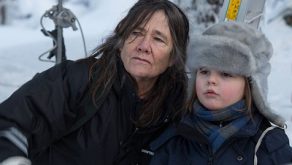 She looks as if she’s coming from a different solar system.
She looks as if she’s coming from a different solar system.
Edfeldt: She actually does… in a way. Lilly is very special.
How were the dynamics between the two main actresses?
Hanno: At first they didn’t like each other much. But once they learned to appreciate each other, they had a really good chemistry. They were always playing. The moment we said ‘cut’, they were already gone, playing.
Were the dynamics in their ‘off stage’ relationship the same as on screen, with one dominating the other?
Hanno: No, it was more complex. Astrid Lövgren (Siv) is a tougher person than you’d think. She might look shy and pensive, but she’s also a powerful girl with a strong will.
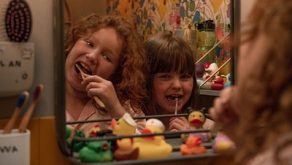 Did you explain to them about the kind of power relationship they have in the film?
Did you explain to them about the kind of power relationship they have in the film?
Hanno: They knew it from the book. We didn’t explain, as that would take it too far. We just made little adjustments here and there to get what we wanted.
Edfeldt: Lilly said that she is almost like Cerisia, but not as mean. She understood there is a certain meanness about her character.
I totally recognised the power games those girls are playing. How come this aspect of the story looks so realistic?
Hanno: When reading the book I immediately remembered my childhood years. There was a girl with whom I used to play as a child, but when we went to school together, she betrayed me. She made me feel like I was stupid, doing unpleasant things to dominate me. Like coming to my house, asking me to sing, and then laughing at me because I couldn’t sing so well. Over the years those memories came back from time to time, and this is how I connected with the book. When starting up this film, I thought about it all the time. In a way this is my revenge. I come from a working class background, my father was a miner. In high school for the first time I met with upper class people. Also this class difference between girls somehow slipped into the story. That’s why it took me so long to write it: I had to connect Pija Lindenbaum’s book with the many personal stories in my head.
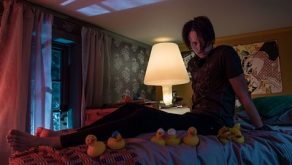 How far away did you move from the book?
How far away did you move from the book?
Edfeldt: Not far, although the book is a short story and now it’s a feature!
Hanno: Many of Pija’s books have been brought to stage. Pija told me that those theatre plays often stayed very close to the original story. She said: for this film I give you the opportunity to go where you want or need to go. She left it up to us, which was helpful for the kind of film we wanted to make. In the end she is happy with the result, although she often asks me about visual details. Pija is a visual person, she is an artist much more than a writer.
For a preschooler audience, SIV SLEEPS ASTRAY might look pretty scary! Elements that have a potential of being very sweet and positive (like plastic ducks, a dog, badgers), in the movie all carry a certain threat.
Edfeldt: That’s how it is to be a child. That is in a way what this movie is about. But Siv is never scared, she’s always curious. By daytime she seems to be a bit afraid of the dog, but not by night.
Hanno: We don’t think it is scary. Children will identify with Siv, and if she’s not scared, they won’t be neither. We were very conscious about this issue and discussed it every day. The famous author Tove Jansson (The Moomins) stated that children have a strong desire to be frightened, within parameters of security. Nowadays in Sweden everyone is so anxious about frightened children, which is ridiculous and harmful for the children. It says a lot about the parents being scared, but as they’re not allowed to, they project it onto their children.
Edfeldt: It is our mission to scare kids!
Hanno: Our mission is to bring children and parents together, watching the same film and discussing it afterwards. That is really important! SIV SLEEPS ASTRAY confronts parents with their childhood memories, but also addresses them as the parents they are now. Somebody said that SIV is ‘very educational for parents’ (not for children!), because it shows how difficult it is to be a child, when so much in the world is new for you.
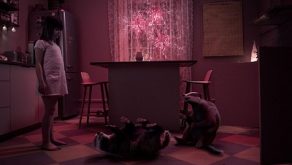 The scene about which I wondered the most why it was there, is when she enters the room of Cerisia’s parents at night and finds those two rather unsympathetic adults.
The scene about which I wondered the most why it was there, is when she enters the room of Cerisia’s parents at night and finds those two rather unsympathetic adults.
Edfeldt: Siv remembers how they were by daytime, and by night this experience gets a life of its own. Just like during the day, the parents are speaking above the head of the child, in a strange language that nobody understands. It’s like when children meet a drunken adult: it scares them as they understand that the personality of a familiar adult somehow has changed.
Hanno: When reading the script, the commissioning editor in Sweden asked us to cut that scene out. But when she finally saw it, she liked it. If it wasn’t there, the film would be left with a narrative gap. Everything happening during the day, comes back at night in a different form or shape, so also the parents should be a part of that dream experience. Children will understand also parents can behave badly: they can drink alcohol, or be mean, or eat in the bed, and nobody makes a problem about it. If children do so, they are considered to be naughty.
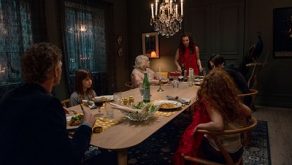 What about the badgers? Can you tell more about them on a technical level?
What about the badgers? Can you tell more about them on a technical level?
Hanno: We didn’t want them to be too ‘cartoony’. We tried at first, but as animated characters they simply didn’t fit into the film; they had to be more grounded. So we worked with computer avatars, even if that’s incredibly expensive. You have to plan the scenes meticulously as every second recording costs a fortune. Every scene with the badgers was done in the computer before we even started to shoot. Later on the set, we didn’t want Astrid to do her acting without a real opponent, so we invited puppeteers to the set. With good results: some of the badgers’ dialogues were adjusted and details were added that were not in the script. For every shot we made with the puppets, we shot another empty frame to insert the badgers afterwards. We even had the badgers’ voice actors on the set and filmed them with head-camera’s. Their facial expressions and gestures inspired us. For those scenes we even involved a choreographer. Then 3 animators worked on the badgers in 3D, using the footage from the puppeteers and the voice actors.
Edfeldt: It was a wonderful process. Often I stood there watching with open mouth. Every Monday we were there, directing the badgers. Monday was badger day!
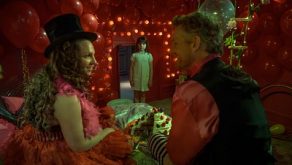 Those badgers are also a bit nasty, aren’t they?
Those badgers are also a bit nasty, aren’t they?
Edfeldt: If they were too cute, they would be boring. Children find them cute anyway, as long as they have fur. Before we added the fur, they looked like big, fat rats.
Hanno: Did you notice the badger blinking at the beginning of the film? In the prologue scene, one of the badgers makes a tiny little blink. This should help the children to get into the film. It might make them remember the fluffy badgers throughout the film and to recognise them later on.
Catti, it’s not the first time you have worked with a co-director. You worked as an assistant on countless productions, from BROTHERS LIONHEART and RONIA, THE ROBBER’S DAUGHTER to KIDS IN DA HOOD and ICE DRAGON.
Edfeldt: Co-directing means ‘double the fun and half the anxiety’. Really! I started as an assistant director, working for Lasse Hallstrom, Olle Hellbom, and many others, and my job was always to direct the children. That’s my niche. I was a child actor myself so I know what it’s all about. I love working with animals and children, and most directors don’t.
Hanno: Since we had clearly separate areas of responsibility, one could always interfere in the other person’s area. Sometimes we didn’t share the same opinion, but we always came to a satisfying conclusion. We had our quarrels from time to time, but never about prestige.
Edfeldt: They called us ‘the badgers’.
Hanno: And I think Catti did a great job with the dog!
Edfeldt: The dog is fantastic! You know the dog’s name was Siv? Purely coincidentally! It’s an old fashioned, very Swedish name. Siv was a half Irish wolfhound, and had a unique expressivity in its face. The owners had two dogs of the same breed, but the other one didn’t have half the charisma. One day Siv got sick and couldn’t come to the set. We tried the other one as stand-in, but it didn’t work. He lacked character. Siv was like a saint, so calm, with an expression of inner peace.
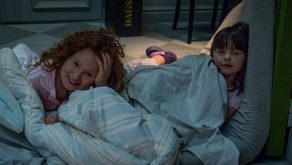 This entire wondrous nightly sequence, I’m a bit reluctant to call it ‘a dream’.
This entire wondrous nightly sequence, I’m a bit reluctant to call it ‘a dream’.
Edfeldt: If you ask the children, they’ll say it’s a dream.
Hanno: Pija said: ‘when I was that age, it wasn’t so clear to me what was a dream and what was not. In my fantasy world, everything sort of floated together.’ Just like in the movie. So I don’t think you should call it a dream. Alice in Wonderland isn’t a dream. It’s… wonderland! Like in BIRDMAN, when you think it’s all fantasy but then in the end it wasn’t. Why would you define what is more fantasy than the other? It’s all in your head anyhow.
Did the young actors know which parts were supposed to be realistic and which parts were more dreamy?
Edfeldt: In a way. In the dream Astrid is always on her own, Lilly is never there.
Hanno: We shot both parts on different sets, because of all the changing elements. The wallpaper changes, the corridor is longer, it has more doors, and many sizes and parameters are changing.
But between dream and reality, there is a moment of transition.
Hanno: There is a moment when all pieces of the puzzle fall into place for Astrid. Exactly on that moment, we inserted a ‘dollyzoom’: the camera zooms in while moving away from her. It’s a camera effect that undermines the audience’s visual perception, a classic technique that Hitchcock often used in VERTIGO (and therefore is called ‘the vertigo effect’). When Scorsese uses it, he takes two days to only plan it, while we had two hours to shoot the bloody thing!
How did the co-production with Holland go?
Hanno: Our Swedish commissioning editor insisted it should be a co-production, but we had our doubts about it. It’s scary to start working with people you don’t know. It makes things more complicated, and more people are getting involved. I was upset when they forced us to have a Dutch composer, while I wanted to work with a Sami musician. Luckily we found somebody who never even heard about Sami, but was really lovely. Merlijn Snitker was a match made in heaven. If possible I’d love to work with him again. He came to stay a couple of days in Catti’s house outside Stockholm, and delivered an excellent piece of work. We’ve become really good advocates for co-production now.
Edfeldt: We’ve had some luck during this journey. But it all ended up so nice!
Gert Hermans
Press Photos © Karolina Pajak
